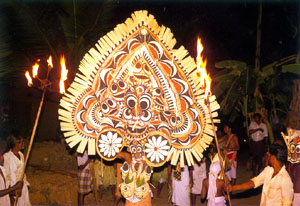|
|

|
|

|
|||
| Ritual Arts | ||||
Patayani
Patayani is a ritualistic dance, which literally means
an array of common people. Patayani involves many powerful themes of
eso teric
appeal. The whole village activity corporate in this popular art. The
figures in Patayani consists of Pisachu, Kali, Karakkura, Pillatini,
Bhairavi, Kalan etc. The masks are painted with a grotesque surrealistic
touch. The round eyes and the triangular ears and abnormal size of the
head gear give a touch of super human dimension.
teric
appeal. The whole village activity corporate in this popular art. The
figures in Patayani consists of Pisachu, Kali, Karakkura, Pillatini,
Bhairavi, Kalan etc. The masks are painted with a grotesque surrealistic
touch. The round eyes and the triangular ears and abnormal size of the
head gear give a touch of super human dimension.
Kala is defeated by Kala Kala who ultimately subjects himself to extreme suffering, struggles hard and collapses only to be awakened to resume the drama of chase. Lord Shiva again comes to bring back Yama to real life.
Patayani is associated with the Devi (goddess) temples of Central Travancore area. At least in a dozen village temples the art finds its existence, with the active corporation of the villagers who share the ritual experience and the responsibilities. The Velan (the sorcerer) plays on his percussion instrument 'Para' when the areca tree is uprooted and ceremoniously placed at the temple premises as the flagstaff of the festival for 28 days which has to conclude on the 'Bharani' day in the month of Meenam. The 'Velichappadu' who is from the Nayar caste gets possessed and dances to the rhythm of the Para and officiates the ritual of uprooting and placing the flagstaff with the help of the villagers. The Mannan (village washerman) who is also in charge of plucking coconuts supplies the areca sheaths and other materials with which the masks are made. The Kaniyan paints the masks. On the next day of the flag hosting ceremony, the villagers assemble in the temple around 10 in the night with lighted torches and go thrice around the shrine articulating meaningless syllables meant for invoking the subordinate spirits who pay homage to the main deity. This is technically called 'Chuttupatayani' or Patayani with torches. This process continue for 18 days. On the 19th day the villagers reach the temple in procession singing boat songs in group in a rhythm peculiar to the rowing of a country boat. In front of the temple before a lighted lamp the neighbouring villagers conduct a group dance called 'Kappoli' as a gesture of corporation to the celebrations. In dancing they show a number of acrobatic martial feat accompanied by singing. The first item proper in the series is 'Tavati' in which six to seven experts dance the basic rhythms of Patayani to the accompaniment of the drum called 'Tappu' a round wooden instrument covered with thick hide.